Nho Que River in Ha Giang – A Journey Through Natural Beauty
Tucked in Ha Giang Province, the Nho Que River is a natural beauty that enthralls everyone who visits. Its emerald-green waves meld elegantly over rocky mountains and deep valleys to produce a breathtaking scene reminiscent of something out of a fairy tale. Let MOTOGO Tours explore this site.

Overview of Nho Que River
Rising from China’s Yunnan hills and running into Vietnam, the Nho Que River winds over 192 kilometers across spectacular terrain marked by terraced rice fields and tall limestone karsts. Particularly bright in the dry season, the river’s famous greenish-blue color contributes to its appeal and is among the most often photographed locations in Ha Giang. For millennia, the nearby people have depended on this river for transportation and irrigation.
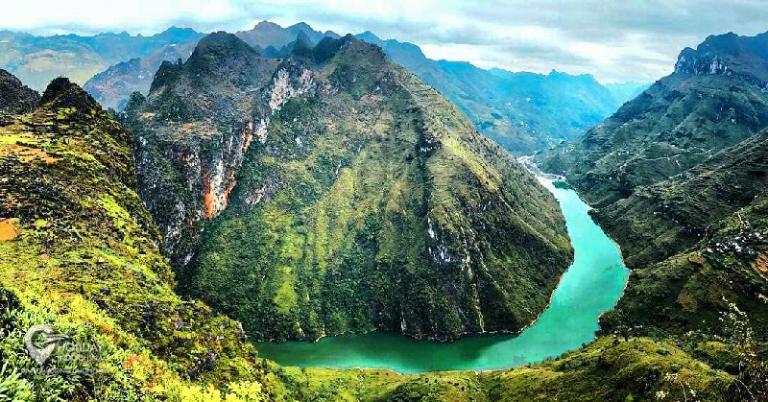
Nho Que River runs through the Dong Van Karst Plateau, a UNESCO Global Geopark known for its unique geological formations and breathtaking scenery. Located near the border with China, the river passes through narrow gorges and steep cliffs, creating a dramatic and otherworldly atmosphere. The Tu San Alley, in particular, is famous for its towering cliffs that plunge straight into the river, forming one of the deepest canyons in Southeast Asia.
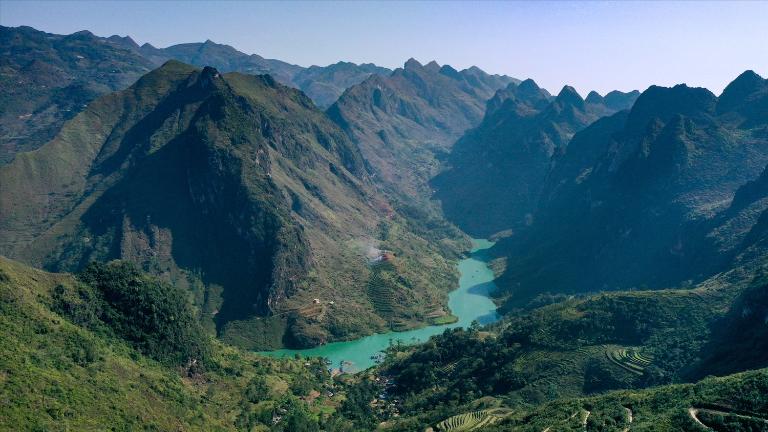
For the local ethnic communities, including the Hmong and Tay people, the Nho Que has historically been vital both culturally and economically. The river helped trade networks so that different areas might trade commodities and cultural practices could be shared. Its valleys also functioned as centers of old agricultural activity; even now, the terraced fields running beside the riverbanks clearly show the conventional farming techniques.
>>> Let’s see more: Must-Visit Destinations in Ha Giang: A Comprehensive Travel Guide
Nho Que River’s Natural Beauty
Limestone Karst Formations
One wonders at the magnificent limestone karst formations lining the Nho Que River. The landscape is even more breathtaking since these magnificent geological formations, developed over millions of years, stand out against the emerald waters. Deep gorges the river has dug into the karsts provide spectacular rocks rising sharply from its surface.
Flora and Fauna
Rich in diversity of flora and animals, the area around the Nho Que River provides a refuge for those who like the natural world. Rich flora with tropical plants and bamboo forests lines the riverbanks. Spotting uncommon species include the oriental magpie-robin and the black-crowned night heron will thrill bird enthusiasts. Different fish species found in the Nho Que River’s waters also provide food for the nearby people.
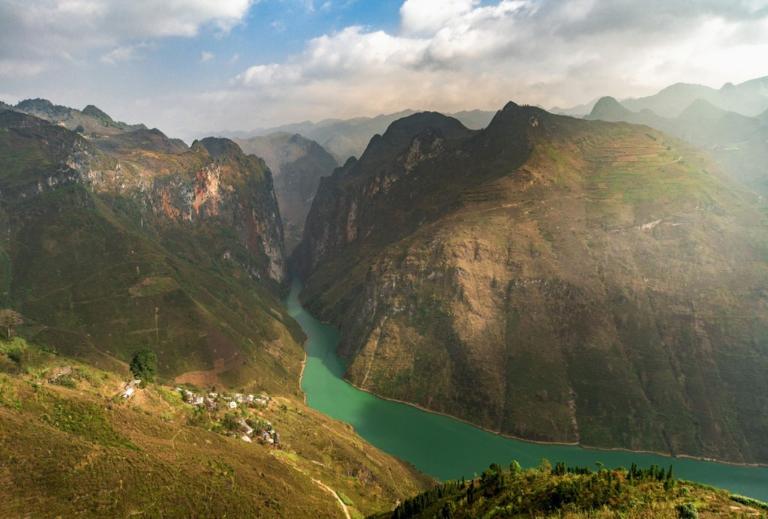
Exploring Nho Que River
Discovering Nho Que River presents an amazing trip across some of the most breathtaking and dramatic settings in Vietnam. Travelers from all around the world are drawn to the natural masterwork created by the river’s calm waters cutting a course across steep mountains and deep gorges.
Boating on the Nho Que River
Navigating your way to a boat trip if this is your first time seeing the Nho Que River in Ha Giang could feel a little intimidating. These basic information will assist you to locate the pier and enjoy your boating trip on the Nho Que River.
Directions to the Nho Que River Pier in Ha Giang
Many guests might not know how to get to the dock of the Nho Que River. Private docks are not now in use. Rather, Ta Lang Pier and Xin Cai Pier are the two primary piers from which to select. Choose the pier suitable for you based on your location and trip plan.
1. Ta Lang Pier
About 4 km from Dong Van, Ta Lang Pier is located in Ta Lang Hamlet, Pai Lung Commune. From the junction of the pine tree road, continue the concrete road and then turn left to arrive to the pier. You will have arrived if you keep straight till you spot indications pointing to the pier.
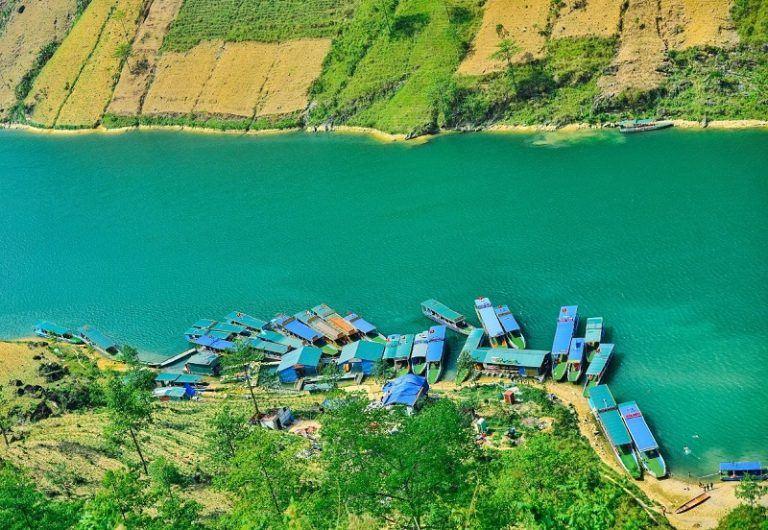
Though the path to Ta Lang Pier is just roughly eight kilometers long, it is somewhat difficult. The road makes multiple abrupt twists and steep rises. If you intend to ride a motorbike, be sure your brakes and tires are completely checked prior. For a safer travel, you might also think about paying a car or cab or appointing a local guide.
But given the small and twisting road getting to the pier, motorists could find trouble. Many visitors so park their cars and walk the two kilometers to the pier. Ta Lang Pier runs about 23 boats to service visitors, hence be ready for possible waiting hours during busy travel seasons.
>>> Let’s see more: Lung Cu Flag Tower: Vietnam’s Northernmost Landmark
2. Xin Cai Pier
First of the three most isolated communes in Meo Vac District is Xin Cai. From the Ma Pi Leng Pass, you will see the road going to Xin Cai running by the Nho Que River. Signs point you at the end of Ma Pi Leng Road. From there, the pier is five kilometers away, then a two-kilometer walk gets one to the boat mooring point.
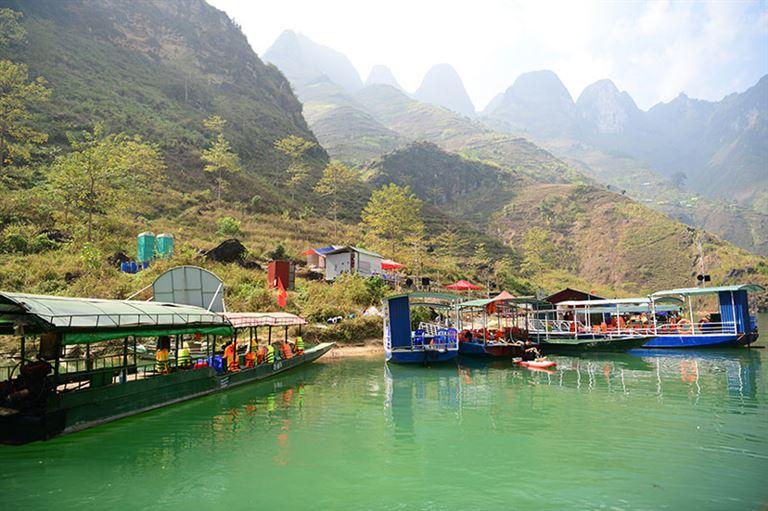
Though the road to Xin Cai Pier is equally difficult as that of Ta Lang, it provides amazing views of the Nho Que River and surrounding terrain from above.
Popular Boat Options
On the Nho Que River, three main forms of boat excursions are kayaking, self-rowing boats, and motorboats. Your tastes, financial situation, and group size will help you to select the most appropriate one.
Motorboats: Motorboats have a strong and cozy seat that lets you relax and take in the riverbank surroundings. Since you may share the boat with other people, it is also a reasonably cost option. Usually ranging from 100,000 VND to 150,000 VND per boat, the rental price offers discounts for full-boat rentals.
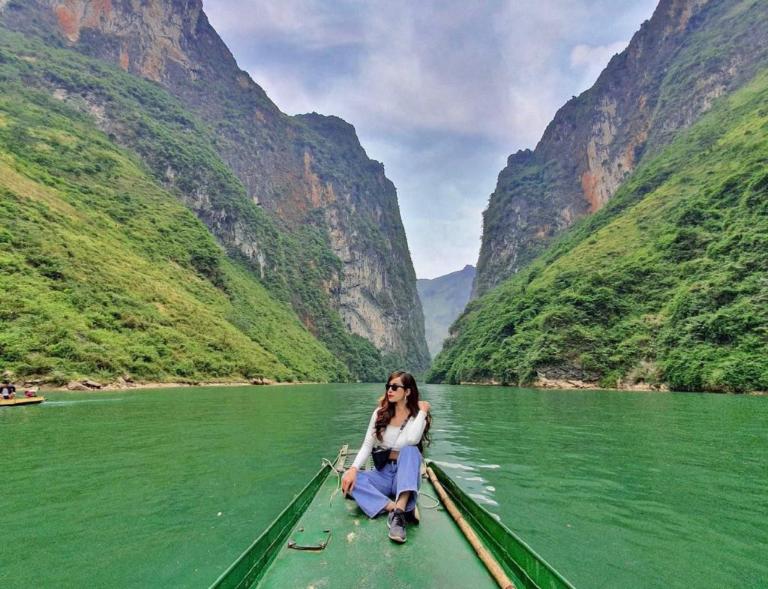
Self-rowing Boats: Self-rowing boats are rented for a like price of 100,000 VND to 150,000 VND if you would want a more hands-on experience. Metal or wooden boats are your options; if you have no rowing skills, you might pay a local rower to go with you.
Kayaking: Kayaking is a water sport becoming rather well-known in Vietnam. Renting a kayak from this location runs just 50,000 VND per person. Kayaks fit even beginners as they are really easy to paddle. Before you start, though, you must make sure you understand the right practices and give safety top priority.
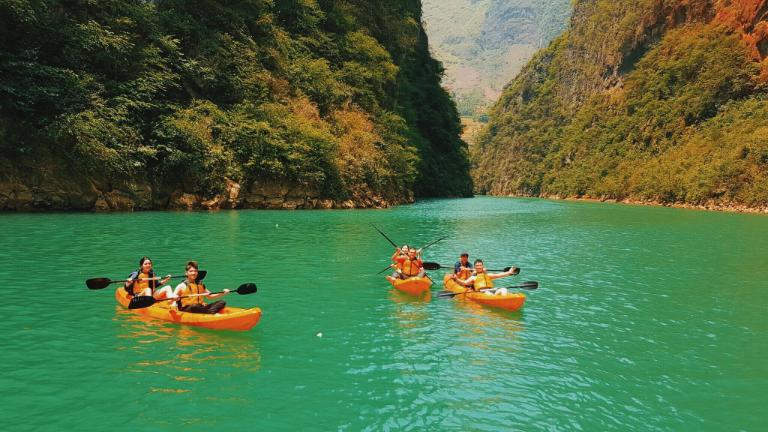
The Nho Que River provides an unforgettable experience for everyone, regardless of their inclination toward adventure or just relaxation and appreciation of the natural beauty.
Hiking Alongside the River
Hiking provides a similarly fulfilling experience for those who would rather explore the Nho Que River actively. Along with the surrounding cliffs and terraced hillsides, several paths run beside the river offering hikers breathtaking views of the water below. Hiking along Nho Que lets guests really appreciate the natural beauty of the surroundings.

Those wishing to explore the Nho Que River on foot find great appeal in several paths. Beginning at the Ma Pi Leng Pass, sometimes referred to as the “King of Vietnam’s Passes,” one of the most advised paths follows With the meandering route and dramatic backdrop created by the steep cliffs, this trek has amazing views of the Nho Que below. The elevation and rough terrain of the climb can be difficult, but the panoramic views make the effort well worth it.
Stunning Photography Spots
Photographers will find paradise on the Nho Que River, which has many chances to capture its unspoiled beauty. Whether you enjoy taking pictures on your trips or you are a professional photographer, the river’s vivid surroundings will surely wow you. Photographs of the turquoise waves, steep cliffs, and rich vegetation show amazing contrast.
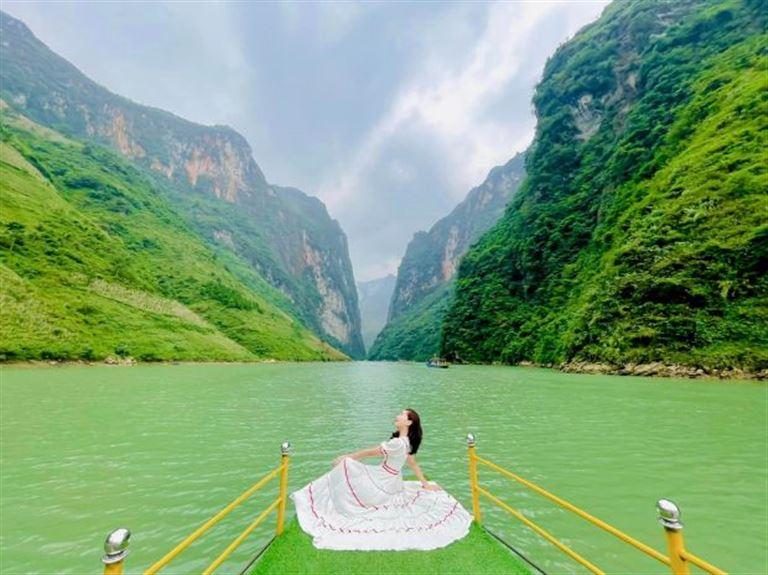
>>> Explore Yen Minh Pine Forest: A Hidden Gem in Vietnam’s Highlands
Tips for Visiting Nho Que River
Best Time to Visit
From October to April, during the dry season, is the perfect time to visit Nho Que River; the river’s waters are at their cleanest and the temperature is mild and pleasant. Visitors can completely enjoy the breathtaking surroundings and engage in outdoor activities including boating and hiking during this season. Particularly to improve your experience, you could go on guided trips such Ha Giang Loop Tour. These guides offer perceptions on the vegetation, animals, and cultural value of this area.
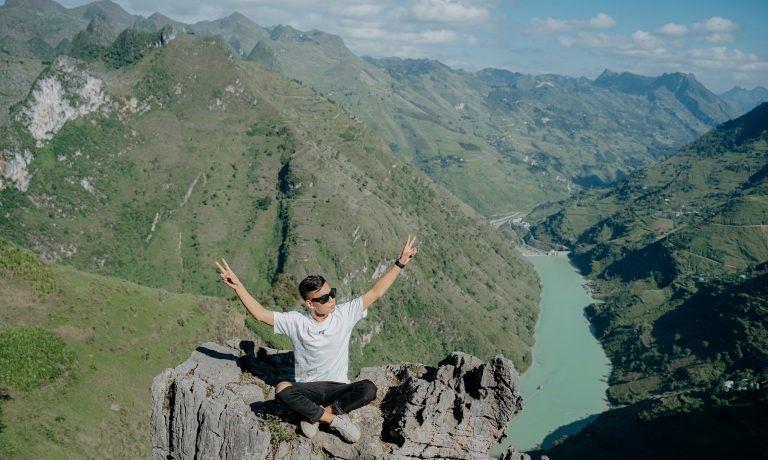
Travel Tips and Precautions
Getting about Ha Giang calls for some planning. Because of the mountains’ changing temperatures, it’s best to dress in layers; strong shoes are very essential for hiking. Always use a life jacket and follow local guide advice when boating. Additionally crucial is honoring regional norms and requesting permission before photographing people.
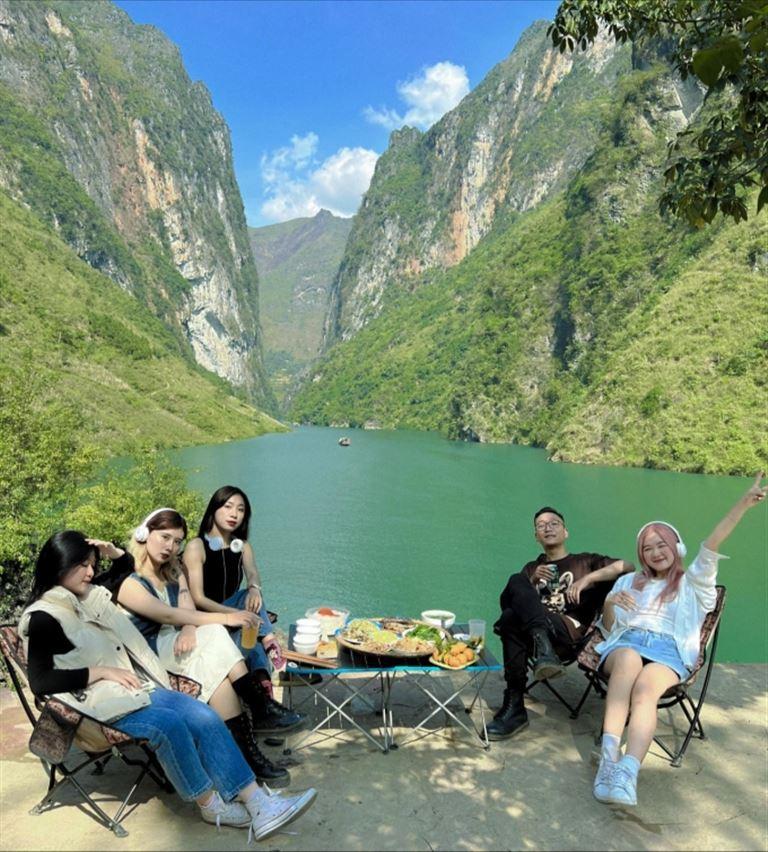
The Nho Que River is a trip into the core of Vietnam’s natural and cultural splendor, not only a river. For photographers, cultural vultures, and nature lovers alike, its emerald rivers, spectacular canyons, and rich legacy make it a must-visit location. Whether your preferred mode of transportation is boat or stroll along its picturesque paths, the encounters you will have will be remarkable.
Frequently Asked Questions about Nho Que River
Q1: How can I get to Nho Que River?
A1: Nho Que River is located in Ha Giang Province, Vietnam. The nearest major town is Dong Van, which is accessible by road. From there, a motorbike or a local taxi will get you to the river. The Ma Pi Leng Pass is the most often used route to reach the river since it provides breathtaking scenery along the way.
Q2: What activities can I do at Nho Que River?
A2: Hiking, boating, and photography abound along this river. The amazing landscape of the Tu San Canyon makes boating through very appealing. Different hiking paths provide offer panoramic views of the river and surroundings. Engaging local ethnic groups will also help you to discover their customs and way of life.
Q3: Is it safe to travel to Nho Que River?
A3: For visitors, the Nho Que is regarded to be safe. On sailing or trekking, guests should exercise caution though. Particularly for boat journeys, wear suitable shoes, pack extra water, and make sure you follow local advice. Additionally smart is to check the weather before leaving since mountain conditions might change quickly.
Q4: Can I swim in the Nho Que River?
A4: Although swimming in some areas of the Nho Que is possible, the strong currents—especially in the small gorges—usually make it not advised. To securely enjoy the water, instead choose a boat trip. Should you decide to swim, be sure you are in a safe region with calm waves and get local counsel first.
Q5: What should I pack for a trip to Nho Que River?
A5: Since temperatures vary throughout the day, pack cozy clothes fit for both cool and warm conditions for a trip to the Nho Que. Additionally advised are strong hiking shoes, a cap, sunscreen, and a waterproof jacket. Bring a waterproof bag including your electronics if you intend to go on a boat trip. Remember your camera to record the breathtaking riverfront!
Related posts:
- Unforgettable Journey to Quan Ba Heaven Gate: A Hidden Gem in Vietnam
- Explore Quan Ba Twin Mountain – A Natural Masterpiece of Ha Giang
- Sung La Valley – A Stunning Blossom Amidst the Rocky Mountains of Ha Giang
- Pho Bang Town: Discover the Hidden Cultural Gem of Ha Giang
- Hmong Kings’ Palace: A Cultural Treasure in Ha Giang








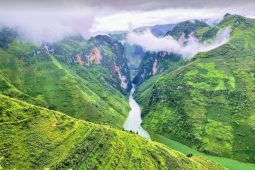
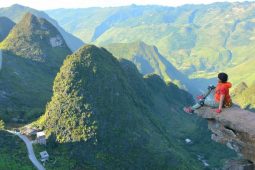
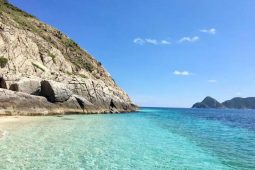
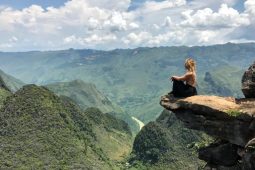
Be the first to comment!